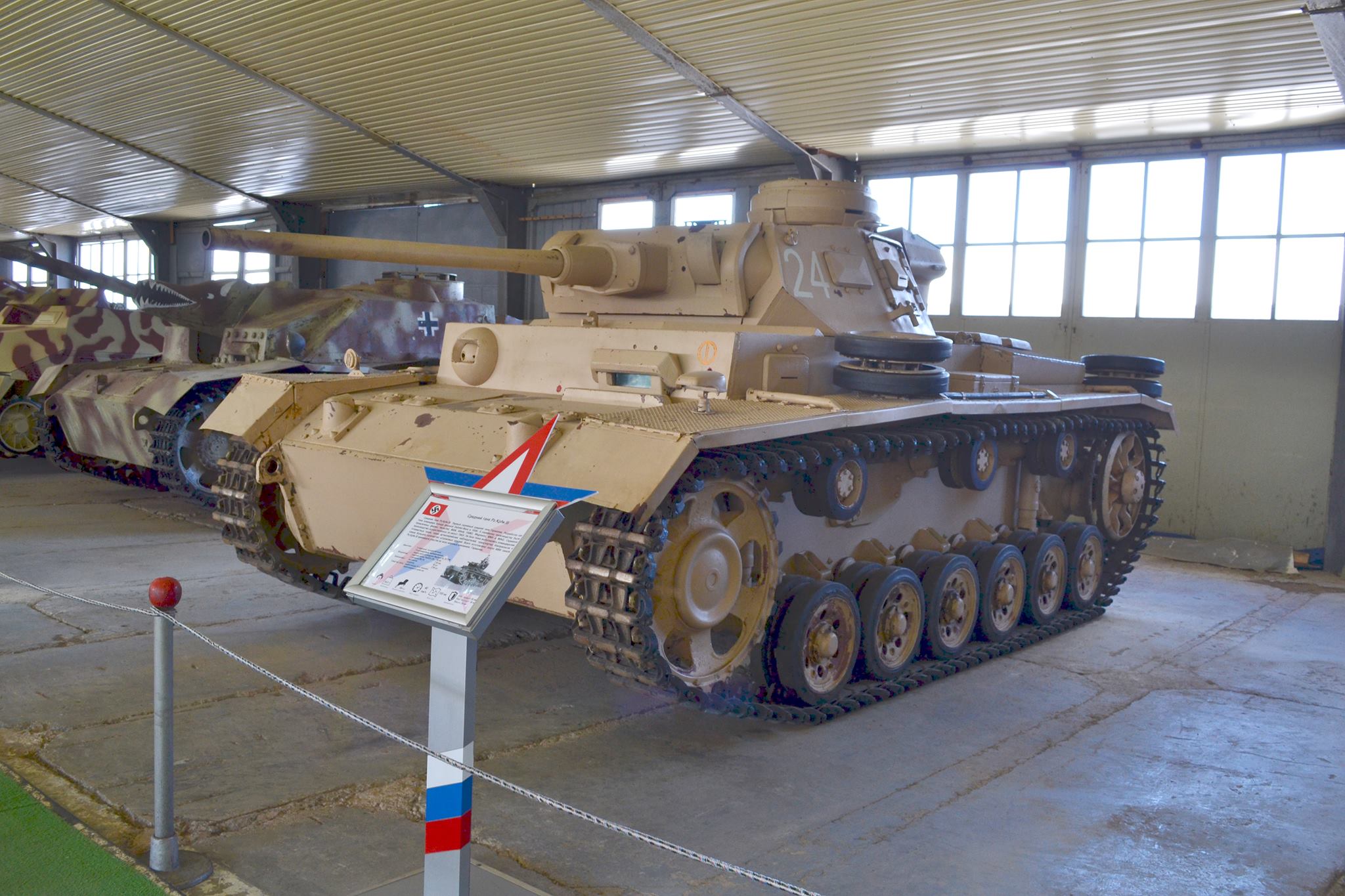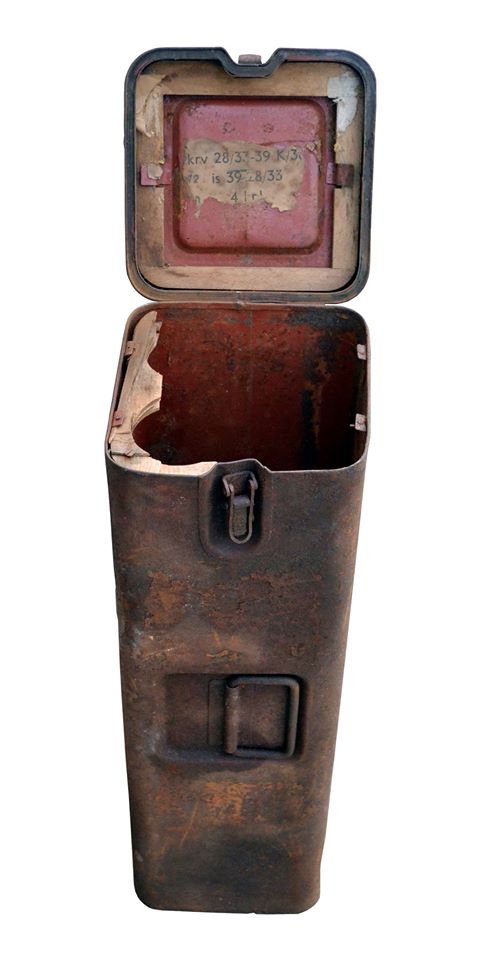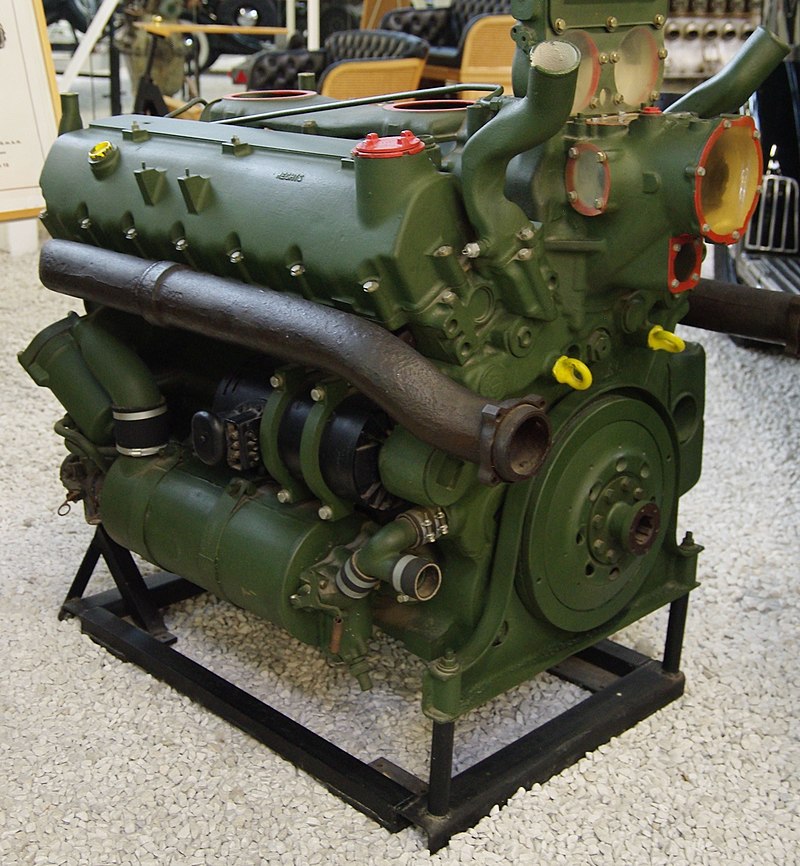Officially designated as the Sd.Kfz. 141, the Panzerkampfwagen III was most commonly referred to simply as the Panzer III. Initially, the Panzer III was intended for use against other tanks, with the Panzer IV designated for the role of direct infantry support, but as the war progressed, these roles would become reversed as the Panzer IV was more easily upgraded. Production of new Panzer III ceased in 1943, although the chassis would continue to be produced as it offered an excellent base for the hulls of assault guns.

Panzer III. Example is displayed at Patriot Park, Moscow.
On 11th January 1934, the weapons department of the army begun to draw up plans for a medium tank following specifications from Heinz Guderian. These would ultimately lead to the creation of the Panzer III as the main tank of the Panzer Divisions. The most obvious differences between the Panzer III and IV is the additional upper guide wheel to carry the returning tracks; however, the intended roles called for the former to be lighter and faster than the latter.
Four manufacturers (Daimler-Benz, Krupp, MAN and Rheinmetall) submitted prototypes with testing carried out between 1936-1937; the Daimler-Benz model was ultimately chosen to go into full production. In May 1937, the first of the initial ten units rolled off the production line; of these only eight were destined to be completed as fully armed examples. The initial units were designated as Ausfuhrung A (Ausf A). Development continued, and by the start of 1939 they were producing the variant Ausf F. Also during this period attempts were made to standardise many parts of the Panzer III's and IV's. It is worth noting that this represents the only real effort made by German industry to standardise vehicle parts during the course of the war; this failure would ultimately contribute towards the eventual downfall of Germany in 1945.

Panzer III. Example is displayed at Patriot Park, Moscow.
On 11th January 1934, the weapons department of the army begun to draw up plans for a medium tank following specifications from Heinz Guderian. These would ultimately lead to the creation of the Panzer III as the main tank of the Panzer Divisions. The most obvious differences between the Panzer III and IV is the additional upper guide wheel to carry the returning tracks; however, the intended roles called for the former to be lighter and faster than the latter.
Four manufacturers (Daimler-Benz, Krupp, MAN and Rheinmetall) submitted prototypes with testing carried out between 1936-1937; the Daimler-Benz model was ultimately chosen to go into full production. In May 1937, the first of the initial ten units rolled off the production line; of these only eight were destined to be completed as fully armed examples. The initial units were designated as Ausfuhrung A (Ausf A). Development continued, and by the start of 1939 they were producing the variant Ausf F. Also during this period attempts were made to standardise many parts of the Panzer III's and IV's. It is worth noting that this represents the only real effort made by German industry to standardise vehicle parts during the course of the war; this failure would ultimately contribute towards the eventual downfall of Germany in 1945.

Upper track support wheel.
One major innovation within German tactical thinking was that the Panzer III saw its commander in sole charge of the tank; normal practice in all nations at this time was for the crew to multitask in their duties over and above their designated roles within the vehicle. This new idea of freeing the commander to concentrate entirely on his role placed the Panzer III at a massive tactical advantage over its foes.

Ammunition carrier for the later models mounting the 75 mm gun.
In terms of armoured protection, the Panzer III variants Ausf A-C initially had 15 mm (0.59 in) at the sides, 10 mm (0,39 in) on the top and 5 mm (0,20 in) underneath. The armour itself was hot-rolled homogeneous, which combined the various steels, rather than producing the protection by means of adding layers. From the advent of the Ausf D onwards, the armour was increased to 30 mm (1.18 in) at the front, back and sides. Further upgrades beyond this would continue as the war progressed.

5cm exploded shell case from a Panzer III
As the intended use of the Panzer III was for tank-on-tank combat, initially the intention was to fit a 50 mm (1.97 in) main gun, per the specification. As the infantry at this time were armed with the Pak 36 (37 mm / 1.45 in) anti-tank gun, it was decided to arm the Panzer III with a gun of the same calibre. By way of a compromise, the turret ring was increased in diameter to allow for a future retrofit of a 50 mm gun further down the line; this compromise provided the Panzer III with a longer life-span than would have been the case without it. Variants Ausf A through to early Ausf G were armed with the 37 mm Kwk 36 L/45 main gun, which proved adequate during the conflicts of 1939-1940. In addition to the main gun, each tank was provided with two MG34 machine guns (7.92 mm / 0.31 in), one mounted coaxially with the main gun, the other down in the hull at the front.

Maybach HL230. Example displayed at the Technik Museum Sinsheim.
Variants Ausf A-D were powered by the 250 PS (184kW) 12-cylinder Maybach HL108 engine which delivered a top speed of 35 km/h (22 mph). Later variants were fitted with an upgraded 200PS (221kW) 12-cylinder Maybach HL 120 engine, increased the maximum speed to 40 km/h (25 mph). The Ausf A-D carried 300 litres (65.99 gallons) of fuel and the Ausf E-G, 320 litres (70.39 gallons). Maximum road range was 165 km (103 miles) and across country ,155 km (59 miles)
Back

5cm exploded shell case from a Panzer III
As the intended use of the Panzer III was for tank-on-tank combat, initially the intention was to fit a 50 mm (1.97 in) main gun, per the specification. As the infantry at this time were armed with the Pak 36 (37 mm / 1.45 in) anti-tank gun, it was decided to arm the Panzer III with a gun of the same calibre. By way of a compromise, the turret ring was increased in diameter to allow for a future retrofit of a 50 mm gun further down the line; this compromise provided the Panzer III with a longer life-span than would have been the case without it. Variants Ausf A through to early Ausf G were armed with the 37 mm Kwk 36 L/45 main gun, which proved adequate during the conflicts of 1939-1940. In addition to the main gun, each tank was provided with two MG34 machine guns (7.92 mm / 0.31 in), one mounted coaxially with the main gun, the other down in the hull at the front.

Maybach HL230. Example displayed at the Technik Museum Sinsheim.
Variants Ausf A-D were powered by the 250 PS (184kW) 12-cylinder Maybach HL108 engine which delivered a top speed of 35 km/h (22 mph). Later variants were fitted with an upgraded 200PS (221kW) 12-cylinder Maybach HL 120 engine, increased the maximum speed to 40 km/h (25 mph). The Ausf A-D carried 300 litres (65.99 gallons) of fuel and the Ausf E-G, 320 litres (70.39 gallons). Maximum road range was 165 km (103 miles) and across country ,155 km (59 miles)
Back
